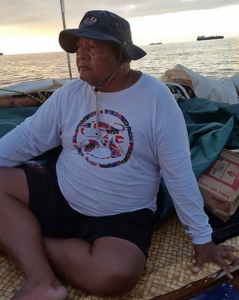
09 Jul Master navigator leads canoe voyage. Article by: Marianas Variety
Master navigator leads canoe voyage. Article by: Marianas Variety
By Sophia Perez – sophia@mvariety.com – Variety Features Writer
The traditional Chamorro sakman Fanhigåyan Guåhan returned to Guam last Sunday after sailing to Saipan and back.
Palu or Master Navigator Ali Haleyalur of Lamotrek led the voyage, working alongside Traditions Affirming Our Seafaring Ancestry (TASA)to revive seafaring traditions in Micronesia.
TASA aims to develop and support the documentation, research, and teaching of Micronesian cultural heritage, create local and regional opportunities for capacity building in traditional seafaring and navigation practices and promote Micronesia’s seafaring heritage through tourism.
“The passion for anything can only be transmitted through its practice,” said TASA President Sandra Iseke Okada.“Revitalization requires capacity building in these threatened and/or disrupted traditions. This open ocean voyage is also about building the capacity of Guam’s traditional seafarers.”Along with Okada and Palu Ali, the Fanhigåyan Guåhan crew included Jesse Piyelur (Lamotrek), Johannes Hashigluw (Lamotrek), Vicente “Gue’lu” Rosario (Luta), and Ned Pablo (Guåhan).They were escorted by Captain Cecilio Raiukiulipiy’s SV Remedy, crewed by Innocenti Eraekaiut (Satawal, FSM), Glenn Rafifimwai (Satawal, FSM), Scott Suzuki(Chuuk, FSM), Andrea Carr (Japanese American), and Cecelia Selepeo (Pagan).
The voyagers set sail on Sunday, May 13 and stopped in Luta, where, according to Palu Ali, they received something akin to a hero’s welcome.
“It was so nice in Rota,” he told the Variety. “Once we cleared customs, the villagers brought food and offered cars and that evening they kept bringing us deer and fish…The mayor was first and hosted meals at restaurants on multiple occasions.”
“It doesn’t matter where you go in Rota, people greet you and act like they know you, offer food and drinks,” he continued.“It’s so beautiful. I would love to stay there. It’s still not spoiled by Western ways…it’s still traditional. I love it.”
The crew enjoyed Luta’s generous hospitality for two days before heading to Saipan, where they were met with the considerable rainstorm that hit the island on the 17th.
PaluAli said that Fanhigåyan Guåhan threatened to sink in the heavy rains, and the crew only narrowly managed to bail out the canoe. Finally, at 5pm, the Fanhigåyan Guåhan crew was received at a welcome barbeque in Susupe hosted by friends, family, and members of the canoe community.
Reflecting on the first half of the trip, Palu Ali said, “I was really excited because this is my first time sailing from Guam to Saipan and I really wanted to explore these sea lanes.”
Sea lanes are ocean routes that boats take from one landmass to another.
“The crew was good, everyone got along, they all listened to my orders so I was very happy with them,” Palu Ali added. He also offered some insight on his navigation methods:
“Going from Guam to Rota I can use the islands as a reference point,” he explained,“but between Rota to here [Saipan] I made an imaginary reference island – I created a reference point in the stars and kept checking back…to know how far I was from my point of departure.”
TASA exists to preservenavigation methods like this one; without traditional navigation knowledge, Micronesians will be forced to rely on Western technology and culture to travel across their own ancestral lands.
But Uncle Ali, who teaches a navigation school in Yap, is confident that navigational knowledge will carry on to the next generation of islanders.
“I think what we are doing now will trigger the young ones to start learning traditional navigation,” he told the Variety. “I want them to remember all these things because otherwise Western influence will cause this to fade away. I want them to have both.”
“When they become navigators themselves, they will be very happy.”
Palu Ali Haleyalur will remain in Guahan for a week before returning to Yap. The crew of SV Remedy will sail back to Saipan in the coming days. As for TASA, the organization continues to barrel forward with its vision.
“To further efforts in achieving our mission, TASA has just been entrusted with the canoe house located at the Paseo de Susanna,” Okada said.“Our organization will be refurbishing the canoe house and begin hosting an ‘open house’ every Wednesday evening to showcase to visitors and locals alike the revival of our ancient seafaring tradition.”


